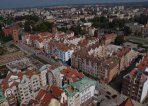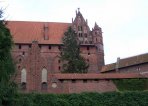| Spis treści |
|---|
| History |
| Interesting website |
| Wszystkie strony |

![]() Before World War II the building was divided into a number of small flats with only one bathroom on one floor. Its former German inhabitants say that the cellar housed a colonial shop which could only be entered through wooden latches in the street. In the backyard the building was extended with a wooden shed holding a kitchen and a big bathing tub… Today, each room is equipped with private bathroom, telephone, TV and the internet access.
Before World War II the building was divided into a number of small flats with only one bathroom on one floor. Its former German inhabitants say that the cellar housed a colonial shop which could only be entered through wooden latches in the street. In the backyard the building was extended with a wooden shed holding a kitchen and a big bathing tub… Today, each room is equipped with private bathroom, telephone, TV and the internet access.

![]() The building was destroyed in 1945 during heavy fights over the town, and then its remaining fragments were tore down and the bricks transported to Warsaw to help rebuild the capital…
The building was destroyed in 1945 during heavy fights over the town, and then its remaining fragments were tore down and the bricks transported to Warsaw to help rebuild the capital…

![]() In the 1970’s a plan was drawn up to develop a residential quarter within the premises of the Old Town with square concrete blocks of flats, similar to the one implemented in the neighbouring town of Malbork! Fortunately, Elbląg was spared this nightmarish fate, thanks to the contemporary Ministry of Culture, Professor W. Zin. Since the beginning of the 1980’s, it has been the grounds of the most intensive archaeological works in Poland. So far, almost half a million exhibits have been collected.
In the 1970’s a plan was drawn up to develop a residential quarter within the premises of the Old Town with square concrete blocks of flats, similar to the one implemented in the neighbouring town of Malbork! Fortunately, Elbląg was spared this nightmarish fate, thanks to the contemporary Ministry of Culture, Professor W. Zin. Since the beginning of the 1980’s, it has been the grounds of the most intensive archaeological works in Poland. So far, almost half a million exhibits have been collected.

![]() Today, 30% of the Old Town has been rebuilt (it included around 600 buildings before WWII). It has again become the centre of the old Hansa town. However, the city is currently more and more distant from its industrial traditions, taking on a new role of the perfect base for tourists willing to explore its environs. In this respect, a high level of security, felt both by its inhabitants and visitors, constitutes one of the most essential assets. In 2003 Elbląg was awarded the first prize in the national contest: Safe City – Safe Commune.
Today, 30% of the Old Town has been rebuilt (it included around 600 buildings before WWII). It has again become the centre of the old Hansa town. However, the city is currently more and more distant from its industrial traditions, taking on a new role of the perfect base for tourists willing to explore its environs. In this respect, a high level of security, felt both by its inhabitants and visitors, constitutes one of the most essential assets. In 2003 Elbląg was awarded the first prize in the national contest: Safe City – Safe Commune.

![]() Within reach there are more unique sites, by any standards, including the Elbląg Canal where boats sail on the land, the Cathedral Complex in Frombork or the biggest Teutonic Knights’ Castle in Malbork. The Tri-City (Gdańsk, Gdynia, Sopot), Masurian Lakes or such popular touristy places as Ostróda and Iława remain within relatively short distances. Apart from these, tourists may pay a visit to the less frequented villages of Gronowo, close to the border with the Kaliningrad Region and famous for a large number of storks, or Osiek, Jelonki and Łęcze with their well-preserved timber-framed houses. In Święty Gaj nearby St Wojciech’s Sanctuary is located, commemorating his death in 967 during his christening mission to the first inhabitants in the land: Prussian tribes.
Within reach there are more unique sites, by any standards, including the Elbląg Canal where boats sail on the land, the Cathedral Complex in Frombork or the biggest Teutonic Knights’ Castle in Malbork. The Tri-City (Gdańsk, Gdynia, Sopot), Masurian Lakes or such popular touristy places as Ostróda and Iława remain within relatively short distances. Apart from these, tourists may pay a visit to the less frequented villages of Gronowo, close to the border with the Kaliningrad Region and famous for a large number of storks, or Osiek, Jelonki and Łęcze with their well-preserved timber-framed houses. In Święty Gaj nearby St Wojciech’s Sanctuary is located, commemorating his death in 967 during his christening mission to the first inhabitants in the land: Prussian tribes.


































.JPG)
.JPG)
.JPG)
.JPG)
.JPG)

.JPG)